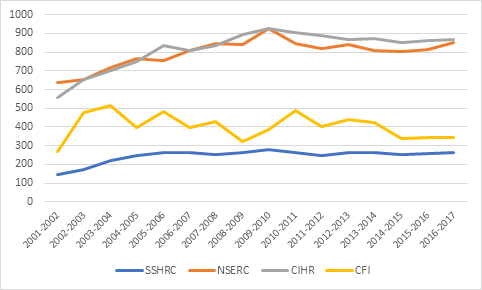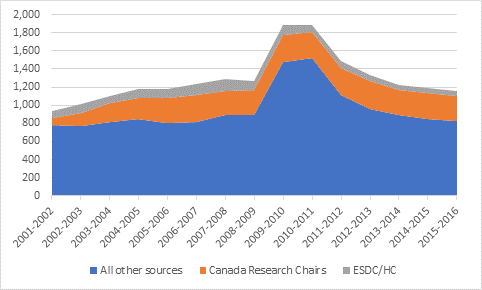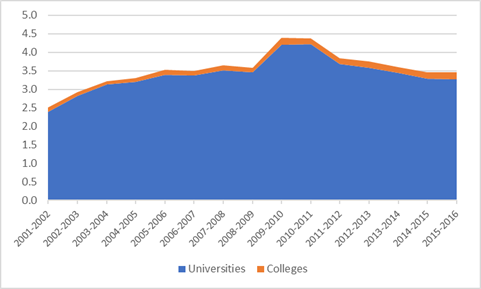The government of Canada has essentially four mechanisms for transferring money to post-secondary institutions. The first, as discussed yesterday, is the indirect means of transfers to provinces. The second is through the research granting councils: the Canadian Institutes for Health Research (CIHR), the Natural Science and Engineering Research Council (NSERC) and the Social Sciences and Humanities Research Council (SSHRC); as of 2018, the Canada Foundation for Innovation (CFI), which disburses money for scientific infrastructure, is now considered the fourth granting council.
The four granting councils provide roughly $2.3 billion in funding to Canadian institutions every year. Close to 99% of this funding goes to universities. This total expenditure figure rose very quickly in the first half of the 2000s, but was roughly unchanged in real terms between 2005-2006 and last year (it will start to rise a bit once the 2018 Budget kicks in). Funding from CIHR and NSERC tend to hew close to one another at around $850 million each; SSHRC funding has stayed very close to $260 million per year for over a decade. Funding from CFI is more erratic, which reflects the fact that it does not yet receive annual funding allocations but instead receives occasional endowment funding.
Figure 1: Research Granting Council Expenditures by Council, 2001-02 to 2016-17, in millions of $2016

On top of that, you have direct funding to institutions, which takes three main forms. The largest single recurring source of funds are the Canada Research Chairs, which provides roughly $275 million every year to Canadian universities to support talented researchers. Another funding channel route is through a variety of other scientific agencies and government departments which transfer at least some of their monies to post-secondary institutions. For instance, Health Canada provides about $30 million per year to universities under various contracts; colleges receive roughly similar sums from Employment and Social Development Canada (both figures bounce around quite a lot from one year to the next though). On top of that, cash also flows through various specialized science agencies such as Brain Canada, Genome Canada, etc.
Some money flows to PSE institutions through regional development agencies, mainly for infrastructure. Periodically, during periods of economic downturn, these funds are supplemented by major expenditures on university and college infrastructure through programs such as the 2009 Knowledge Infrastructure Program (KIP) and the nearly-identical Strategic Infrastructure Fund (SIF). From a government perspective, these programs are as much Keynesian counter-cyclical support to the construction industry during economic downturns as they are about higher education. Nevertheless, these funds have permitted significant renewal and expansion of facilities on Canadian campuses over the past decade.
Figure 2 shows total expenditures from these two channels. Unfortunately, only the Research Chairs, Health Canada and ESDC is broken out from the total from the way Statistics Canada breaks down the data in the FIUC and FINCOL surveys. Infrastructure funding, funds that go through other departments or through channels, like Genome Canada, are not broken out. The long-term average from all these sources is about $1.2 billion, with a jump of about 50% during the 08-09 recession (note that because of the time lag in available data, the effects of post-2016 SIF program funding do not appear in figure 2, but we know it was of a similar magnitude).
Figure 2 – Other Federal Funding, 2001-02 to 2015-16, Canada, in millions of $2016

One final point to note is the institutional distribution of this spending. Federal funding is – to put it mildly – massively geared towards universities. As figure 3 shows, of the $3.5 – $4.5 billion in annual expenditures, only about 5% (and sometimes much less) goes to colleges/polytechnics. Obviously, this is a function of the federal focus on research, which remains primarily located in universities. But the extent of the imbalance is perhaps somewhat surprising, given the major potential productivity-enhancing effects of certain types of college infrastructure (see my previous post on this for more details).
Figure 3 – Total Federal Funding, 2001-02 to 2015-16, Canada, in billions of $2016

More on federal expenditures tomorrow.

 Tweet this post
Tweet this post
